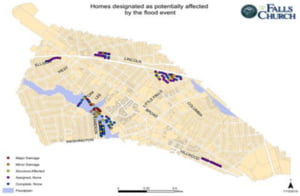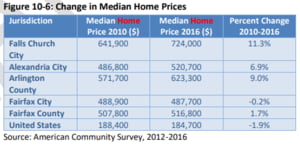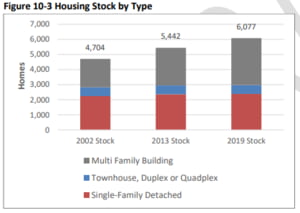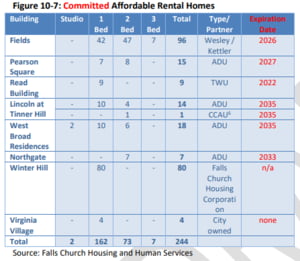Updates from Letty – July 19, 2019 – last one of the summer!
Blog posts are the personal views of Letty Hardi and not official statements or records on behalf of the Falls Church City Council
Dear Friends,
It’s a scorcher out there! As this heat wave intensifies, it’s always a good reminder to check on your elderly neighbors and keep yourself and pets well hydrated (and off the hot sidewalks!) The first half of our work session was also focused on the severe weather that led to last week’s historical flooding, including a discussion on future mitigation.
The most weighty topic was our joint session with the Planning Commission on housing affordability. For those who have been concerned about affordability (and the ensuing impacts to the diversity of our community), you should check out the newest draft of the housing chapter or at least my takeaways below. The data speaks for itself – and it should be a loud call to action for us. Not only are we facing a regional housing shortage, we need to get serious about prioritizing, staffing, and funding projects to stem our affordability crisis. I share my thoughts below on what I think should be our top priorities.
City Council will be on summer recess until our next meeting on August 12. Come see me in person at my office hours on Monday, July 29 at 9 am at the downtown park. Share your thoughts about affordability, economic development, capital projects, traffic calming – I want to hear from you before I kick off my re-election campaign!
Stay cool,
Letty
PS – my weekly blog posts will be on hiatus until after Labor Day – which will be my longest break ever! This is a long post, so add this to your summer reading list and get informed. I will continue to be accessible via email.
What Happened This Week
(1) Flooding Aftermath
Recovery Efforts:
There is still much clean up and recovery happening across the city. Note that if you scheduled a bulk trash pick up for your flood damaged items, it might be collected into next week due to the high volume. As you can see, homes outside the current flood plain (shaded blue area) were impacted which points to the severity and historic nature of the flooding.

Beyond the emergency declaration we made, the City has been partnering with our neighboring localities on eligibility for public assistance. Unfortunately because the flooding was limited to the immediate region, while the City met the damage threshold limit, Virginia will not meet its threshold which means we are ineligible for FEMA assistance. State funding may be available at the discretion of the Governor that staff is assessing. More details on eligibility here.
Safety inspections have been happening in flood-damaged areas. Good news about the prominent closure at the S. Oak St. bridge: the bridge can be reopened after the damaged asphalt is repaved.
Future Mitigation:
Most of our mitigation discussion centered on stormwater projects (page 16+). The watershed management plan was last adopted in 2012, which is funded with bonds and proceeds from stormwater fees. Recognizing that no project could have entirely mitigated the impact of storms like last week’s “100+ year storm”, we still recognize that flooding and severe weather is increasing in frequency. As such, we asked that staff look at reprioritizing and accelerating the stormwater projects, which means we may need to consider additional revenue (grants, increased bonding, higher stormwater fees) to fund the work.
Beyond actions at the broadest city level, enforcing code compliance for construction – such as requiring on site water detention for residential redevelopment (vs allowing off site credits or allowing the run off to flow into the city system) and individual homeowners taking action can help. Reducing impervious surfaces like driveways, grading away from houses, installing rain gardens and rain barrels – every little bit counts! (And it may reduce your stormwater fee if your improvements qualify for credits.)
(2) Housing & Affordability
The Housing Chapter of the Comp Plan (the strategic plan guiding the future of the city) has been significantly overhauled since our last discussion as you can tell by the volume of changes in redline. My thanks to staff who has incorporated feedback from rounds of community and board and commission input, resulting in this latest draft.
I’m a big fan of sharing facts and in this case, a few especially noteworthy new pieces of data tell the story very clearly:
- It’s expensive to live here! We all know that it’s expensive to live in Falls Church. (In fact, my ideas to address affordability was the subject of one of my first blog posts in 2015!) Did you know that we have the highest median home prices and the largest increase in prices? Great for existing homeowners’ property values if you are selling, but not so great for anyone trying to establish roots in our community.

- The Missing Middle: We have added much needed housing stock in the city, primarily in the form of multifamily condos and apartments. This was a deliberate strategy 15+ years ago when the city recognized the need to diversify our tax base. What has not been added is middle housing. We are not alone with the “missing middle” issue (this Bloomberg article does a good job explaining why). In addition, the “affordable” single family home is becoming more and more elusive. When teardowns and starter homes start at $700K, Falls Church is increasingly inaccessible for the two ends of the lifecycle spectrum (recent graduates and retirees) and the traditional middle class. Teachers, city hall workers, waitstaff, etc may have full-time jobs but have to live an hour+ away because we have no housing stock for their income levels. In turn, local businesses have a harder time attracting employees and their commutes add to the region’s congestion issues.

- Affordable Housing Stock is Disappearing: For those of you new to the affordable housing discussion, we have 3 kinds of affordable housing, none of which are what you think of as “Section 8 housing” or “public housing” slums. We have 1) market rate affordable rentals, ie housing that is naturally affordable because it is older stock or has less amenities; 2) committed affordable rentals, ie rental housing that is negotiated with the city to be affordable – usually the new developments designate 6% of their total units as affordable; and 3) committed ownership units, ie condos that were negotiated with an affordable sales price for a new homebuyer. The majority of these three kinds of housing is for people with incomes between 60-80% of Area Median Income (which is about $100K for the DC region).
As you can see below, the total stock of affordable housing has dropped significantly, driven primarily by the decrease in market rate units, in which the city has little control.
The Fields falls in the 2nd category, committed affordable housing, with an affordability provision that expires in 2026. One of the most striking new pieces of data I’ve asked for is the expiration dates for the rest of our affordable housing stock, in the chart below. 65% of our committed affordable rental units will also expire in the next 10-15 years. The Fields, at 96 housing units, is currently the most discussed and represents the largest segment – but losing the rest in the years that immediately follow needs to be a wake up call. (The ownership units, not shown below, also have expirations.)
There is some decent news. We’ve negotiated that all the new developments we approved the past three years adhere to our newly adopted policy that committed affordable units will never expire. Between Founders Row, Broad & Washington, and the West Falls Church projects, we expect to gain new units (6% of all units, or approximately 80 units) that won’t expire and have the option to convert to some or all to a cash equivalent that can be used for affordable housing needs elsewhere .
Letty’s thoughts – so what are we going to do about this? On pages 18-22 of the Housing Chapter are proposed strategies and a good mix of aspirational and practical projects. There is no shortage of ideas and work we could do, with some luckily underway like the expansion of senior tax relief we recently passed. That said, in my 3 years on Council – we’ve talked about affordability a lot, but with our attention on the big capital projects, we haven’t had a majority willing to take action.
We need to rally around a handful of impactful, yet concrete and realistic, priorities – let’s start somewhere. So out of the 20+ ideas proposed, what would be my priorities? It’s clear to me that not only do we need to preserve the affordable housing we’ve got – we have to add more. More housing diversity, more housing supply, more options for people to be able to live and stay here.
1) Many of the ideas need money. We need a sustainable funding source to replenish the affordable housing fund that was depleted 10 years ago. While we’ve been investing in many catch-up capital projects, we need to decide whether we’re ready to turn our attention to housing and support our “welcoming and inclusive” community values with a dedicated revenue stream to fund these ideas. Our property taxes are already high – and this doesn’t have to come from a property tax increase, which could exacerbate affordability issues. We can carve it out of the existing operating budget or create a new revenue source like an increase in the meals tax, increase in the transit occupancy tax, convert upcoming units to cash, or some combination.
2) We need a creative plan to preserve The Fields. We cannot afford to lose 1/3 of our affordable housing stock in one fell swoop. Beyond partnering with the existing owners, I’d like us to consider redevelopment and density options that would enable us to preserve and/or renovate the existing units and add mixed income, workforce housing.
3) Zoning – there is a lot we can do here. I’ll preface by agreeing with the skeptics that zoning changes can have far-reaching impacts and need to be carefully considered. At the minimum, let’s consider zoning tools to incent renovations vs teardowns while respecting individual property rights. Regionally, accessory dwelling units (aka granny flats) are gaining steam – enabling additional density in residential neighborhoods could add affordable housing stock. And nationally – we could learn from bold moves like Minneapolis and Oregon’s elimination of single family zoning that will create more affordability and racial and economic equity. And finally, continuing mixed use development – which not only adds to our tax base and keeps taxes from rising as much as it otherwise would – it also adds more diverse housing and helps our progression from car-centric suburb to a sustainable, walkable community.
The Housing Chapter is scheduled to be approved in our August meeting. Following that, my request to staff is to propose the next level action plan – preferably well before the next budget and work plan cycles start in early 2020 so we can vote on a realistic set of priorities and support it with resources.
In the meantime, I want to hear from you!
(3) CIP Review
As we do every quarter, we reviewed a snapshot of the key CIP (capital improvements program) projects across the city. As capital projects have been our largest focus in recent years, typically this would merit its own, long post – but I’ll keep it short this time.
My quick takeaway:
As you can see from the status report, we have a lot of projects in progress, especially in the area of transportation where bike-friendly, walkability, and ped safety projects have gotten top billing, reflecting this City Council’s focus. An ongoing risk I share is that many projects are coming in above budget (partly due to rising construction costs) and we’re short on resources, which is never a good combination. I will continue to push that we’re deliberate on which big projects we take on so we deliver them well.
What’s Coming Up
- Monday, July 29 – Letty’s Office Hours (9 am, Downtown Park)
- Monday, August 12 – City Council Regular Meeting (730 pm, City Hall)
- Tuesday, September 3 – City Council Regular Meeting (730 pm, City Hall)

